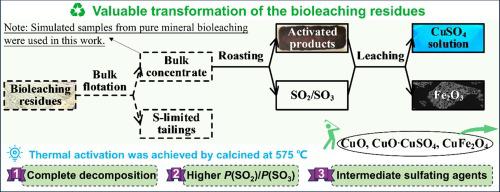当前位置:
X-MOL 学术
›
Miner. Eng.
›
论文详情
Our official English website, www.x-mol.net, welcomes your feedback! (Note: you will need to create a separate account there.)
Recovery of copper from bioleaching residues containing chalcopyrite through calcination-leaching: Emphasis on the presence of pyrite
Minerals Engineering ( IF 4.9 ) Pub Date : 2024-05-21 , DOI: 10.1016/j.mineng.2024.108737 Yisheng Zhang , Lijuan Bai , Zuchao Pan , Mingtong Zhang , Li Shen , Guohua Gu , Hongbo Zhao
Minerals Engineering ( IF 4.9 ) Pub Date : 2024-05-21 , DOI: 10.1016/j.mineng.2024.108737 Yisheng Zhang , Lijuan Bai , Zuchao Pan , Mingtong Zhang , Li Shen , Guohua Gu , Hongbo Zhao

|
The industrial application of bioleaching of copper ore has been developed for decades. As the easily soluble copper ore is gradually depleted, the refractory chalcopyrite becomes an increasing proportion of the original ore. Partially undissolved chalcopyrite, along with its associated pyrite, bioleaching intermediates, and microorganisms, are deposited in tailings. These tailings represent a significant environmental hazard but also a potential copper-bearing resource. In this regard, a synergistic calcination-leaching treatment method for bulk flotation was proposed, and calcination-leaching research was carried out on the bioleaching residues of pure chalcopyrite and mixed chalcopyrite-pyrite ore and control groups (chalcopyrite, pyrite and mixed chalcopyrite-pyrite ore) in this work. Calcination was carried out at 275 °C, 375 °C, 475 °C, 575 °C and 675 °C. The calcined products were then leached with 10 wt% HSO at a solid/liquid ratio of 0.5 g/10 mL. The results indicated that the thermal activation of the mixed chalcopyrite-pyrite ore bioleaching residues occurred at 575 °C, and the presence of pyrite and the bioleaching intermediate elemental sulfur promoted copper recovery from the bioleaching residue up to 94.9 % with only 0.41 % iron leached. Combining the results of the leaching experiments, solid characterization, and thermal decomposition analysis, the underlying thermal decomposition mechanism was discussed in terms of competitive O consumption, SO partial pressure, temperature, and the formation of intermediate sulfation products. Furthermore, the final solid product consisted mainly of high-purity hematite with a multivoid framework structure, demonstrating the achievement of valuable and benign transformation of the bioleaching residue.
中文翻译:

通过煅烧浸出从含有黄铜矿的生物浸出残渣中回收铜:强调黄铁矿的存在
铜矿石生物浸出的工业应用已经发展了几十年。随着易溶铜矿石逐渐枯竭,难熔黄铜矿在原矿石中所占的比例越来越大。部分未溶解的黄铜矿及其伴生的黄铁矿、生物浸出中间体和微生物沉积在尾矿中。这些尾矿不仅对环境造成重大危害,而且也是潜在的含铜资源。对此,提出了散装浮选协同煅烧浸出处理方法,对纯黄铜矿和黄铜矿-黄铁矿混合矿及对照组(黄铜矿、黄铁矿和黄铜矿-黄铁矿混合矿)的生物浸出渣进行了煅烧-浸出研究矿石)在这项工作中。煅烧在275℃、375℃、475℃、575℃和675℃下进行。然后用 10 wt% HSO 以 0.5 g/10 mL 的固/液比浸出煅烧后的产品。结果表明,混合黄铜矿-黄铁矿矿石生物浸出残渣的热活化发生在 575 °C,黄铁矿和生物浸出中间体元素硫的存在促进了生物浸出残渣中铜的回收率高达 94.9%,而铁浸出率仅为 0.41% 。结合浸出实验、固体表征和热分解分析的结果,从竞争性 O 消耗、SO 分压、温度和中间硫酸化产物的形成方面讨论了潜在的热分解机制。此外,最终的固体产品主要由具有多孔骨架结构的高纯度赤铁矿组成,表明生物浸出残渣实现了有价值的良性转化。
更新日期:2024-05-21
中文翻译:

通过煅烧浸出从含有黄铜矿的生物浸出残渣中回收铜:强调黄铁矿的存在
铜矿石生物浸出的工业应用已经发展了几十年。随着易溶铜矿石逐渐枯竭,难熔黄铜矿在原矿石中所占的比例越来越大。部分未溶解的黄铜矿及其伴生的黄铁矿、生物浸出中间体和微生物沉积在尾矿中。这些尾矿不仅对环境造成重大危害,而且也是潜在的含铜资源。对此,提出了散装浮选协同煅烧浸出处理方法,对纯黄铜矿和黄铜矿-黄铁矿混合矿及对照组(黄铜矿、黄铁矿和黄铜矿-黄铁矿混合矿)的生物浸出渣进行了煅烧-浸出研究矿石)在这项工作中。煅烧在275℃、375℃、475℃、575℃和675℃下进行。然后用 10 wt% HSO 以 0.5 g/10 mL 的固/液比浸出煅烧后的产品。结果表明,混合黄铜矿-黄铁矿矿石生物浸出残渣的热活化发生在 575 °C,黄铁矿和生物浸出中间体元素硫的存在促进了生物浸出残渣中铜的回收率高达 94.9%,而铁浸出率仅为 0.41% 。结合浸出实验、固体表征和热分解分析的结果,从竞争性 O 消耗、SO 分压、温度和中间硫酸化产物的形成方面讨论了潜在的热分解机制。此外,最终的固体产品主要由具有多孔骨架结构的高纯度赤铁矿组成,表明生物浸出残渣实现了有价值的良性转化。











































 京公网安备 11010802027423号
京公网安备 11010802027423号